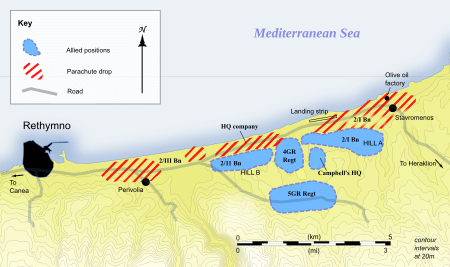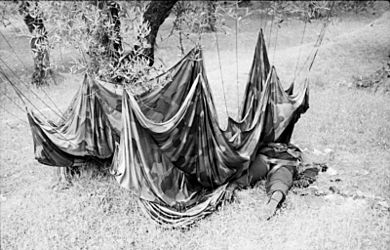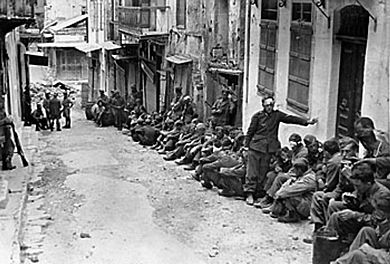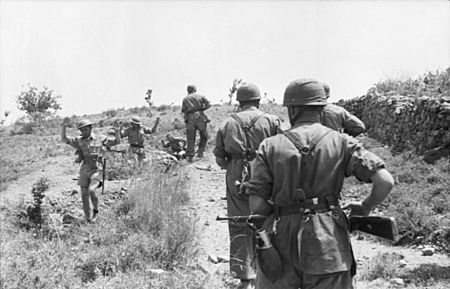Battle of Rethymno facts for kids
Quick facts for kids Battle of Rethymno |
|||||||
|---|---|---|---|---|---|---|---|
| Part of the Battle of Crete | |||||||
|
|||||||
| Belligerents | |||||||
| Allies: |
|||||||
| Commanders and leaders | |||||||
| Strength | |||||||
| • 1,270 Australian infantry • Unknown number of support personnel • 3,100 Greek soldiers & armed police |
• One parachute infantry regiment: c. 1,700 | ||||||
| Casualties and losses | |||||||
| Unknown Almost all Commonwealth troops killed or captured |
Unknown, but heavy | ||||||
The Battle of Rethymno was an important fight during World War II. It happened on the Greek island of Crete from May 20 to 29, 1941. This battle was part of the larger Battle of Crete.
Australian and Greek soldiers, led by Lieutenant-colonel Ian Ross Campbell, defended the town of Rethymno. They also protected a nearby airstrip. They were attacked by German paratroopers from the 2nd Parachute Regiment. This German force was commanded by Colonel Alfred Sturm.
The attack on Rethymno was one of four airborne assaults on Crete that day. German planes were supposed to drop paratroopers and also provide air support. However, there were many problems and delays at the airfields in mainland Greece. This meant the German attack started late and without proper air support. Many German soldiers were shot or injured as they landed.
The main German commander, Lieutenant-general Kurt Student, focused all his efforts on the battle for Maleme airfield. This airfield was about 50 miles (80 km) to the west. The Germans eventually won control of Maleme. The Allied commander, General Archibald Wavell, ordered troops to leave Crete on May 27. But the Allied commander on Crete, Major-general Bernard Freyberg, could not tell Campbell about this order.
Campbell's forces faced many more Germans, who also had tanks and artillery. Campbell surrendered on May 29. Some Australians escaped into the hills with help from the local Cretans. About 52 of them eventually made it to Egypt.
Contents
Why the Battle Happened
Greece joined World War II when Italy invaded it in October 1940. Britain and other Commonwealth countries sent soldiers to help Greece. British forces also guarded Crete. This allowed Greek soldiers from Crete to fight on the mainland. Crete was important because it had good harbors for the Royal Navy in the eastern Mediterranean Sea. British bombers based on Crete could also reach oil fields in Romania.
In April 1941, Germany invaded mainland Greece. The British and Commonwealth forces had to leave. About 57,000 Allied troops were taken away by the Royal Navy. Some were sent to Crete to make its defenses stronger. Many of these soldiers had lost their heavy equipment.
The German Army High Command did not really want to attack Crete. They were busy planning to invade the Soviet Union. But Adolf Hitler was worried about attacks on the Romanian oil fields from Crete. German air force leaders were excited about taking the island with an airborne attack. Hitler ordered the invasion of Crete to use it as an airbase. He said the attack must happen in May and not delay the invasion of the Soviet Union.
Who Fought in the Battle
The Allies
On April 30, 1941, Major-general Bernard Freyberg became the commander on Crete. He noticed there were not enough heavy weapons, equipment, or supplies. Equipment was hard to get in the Mediterranean, especially on Crete.
No Royal Air Force (RAF) planes were based permanently on Crete until April 1941. But airfields were built, radar sites set up, and supplies delivered. By early April, airfields at Maleme and Heraklion were ready. The landing strip at Rethymno was also ready.
About 27,000 Commonwealth troops arrived from mainland Greece. Many had only their personal weapons, or no weapons at all. About 9,000 of them left before the battle began. This left 18,000 Commonwealth troops. With the 14,000 soldiers already there, the Allies had 32,000 Commonwealth troops. They also had 10,000 Greek soldiers.
The Rethymno area was defended by two Australian and two Greek battalions. Lieutenant-colonel Ian Campbell was in charge. Both Australian battalions had fought in mainland Greece. They were experienced soldiers. The Australians had 1,270 veterans. There were also smaller Commonwealth units.
The Greek forces were 2,300 strong. But most had little training and were poorly equipped. They had very little ammunition. Not all Greeks even had rifles. Those who did had fewer than 20 rounds of ammunition each. Many had only three rounds.
Campbell also had eight artillery guns. Four were 75 mm and four were captured Italian 100 mm guns. The town of Rethymno itself was defended by 800 well-armed Greek Gendarmerie (police) cadets. Campbell could talk to Freyberg by radio. But he could not understand secret (encrypted) messages. This made communication very difficult.
The Rethymno landing strip was about 8 miles (13 km) east of the town. It was near the village of Pigi. A ridge of hills overlooked the coast road and the landing strip. This ridge ran from "Hill A" in the east to "Hill B" in the west. "Hill D" to the south offered a clear view inland.
The Australian 2/1st Battalion was on Hill A and the ridge to its west. They had six field guns. The Australian 2/11th Battalion was on and around Hill B. They had two field guns and several machineguns. The Greek 4th Regiment was between the two Australian units. The 5th Regiment was south of the ridge as a backup. Two Matilda II heavy tanks were near the landing strip. Campbell's headquarters was on Hill D. All Allied units were well hidden and dug in. Food was limited, so they found food locally.
The Germans
The entire German attack on Crete was called "Operation Mercury." It was controlled by the 12th Army. The German 8th Air Corps provided air support with 570 planes. The soldiers for the attack were the German 7th Air Division and the 5th Mountain Division. There were 22,000 men in total. They were led by Lieutenant-general Kurt Student. Over 500 Junkers Ju 52 planes were used to carry them.
Student planned four parachute attacks on Allied bases on Crete's north coast. The 7th Air Division would drop first. Then the 5th Mountain Division would arrive by air and sea. The sea transport would also bring heavy equipment.
Before the invasion, the Germans bombed Crete to gain control of the sky. The RAF moved its remaining planes to Egypt. German intelligence thought there were only 5,000 Allied soldiers on Crete. They believed Rethymno had no formal defense. For the Rethymno attack, the Germans sent about 1,700 men from the 2nd Parachute Regiment. This force was led by Colonel Alfred Sturm.
Sturm planned for his 3rd Battalion to drop east of Rethymno and capture the town. His 1st Battalion would drop east of the landing strip and capture it. Sturm himself would land between the two groups with his headquarters.
German Paratroopers
German parachutes had a special design. Soldiers could not jump with large weapons. They wore a coverall over their gear. This meant they could only carry a pistol or a grenade when they jumped. Rifles, automatic weapons, mortars, ammunition, food, and water were dropped in separate containers. Soldiers had to find these containers after landing. Until then, they only had pistols and hand grenades.
German paratroopers had to jump headfirst from their planes. They were trained to land on all fours. This often caused wrist injuries. Once out of the plane, they could not control where they landed. To land close to their weapons, they had to jump from no higher than 400 feet (120 meters). The wind could not be stronger than 14 mph (23 km/h). The transport planes had to fly straight, low, and slowly. This made them easy targets for ground fire. The reliable Ju 52 planes carried 13 paratroopers each. Their weapon containers were carried outside the plane.
The Battle Begins
First Attacks
On the morning of May 20, German paratroopers landed at Maleme airfield and near Chania. The planes that dropped them were supposed to drop more soldiers at Rethymno and Heraklion later. But the German airfields in Greece had problems. Dust clouds made it hard to take off and land. Some Ju 52s crashed. Refueling took longer than expected.
The parachute drop was planned for 2:00 PM. It was supposed to happen after German air attacks. These attacks would force defenders to hide and disrupt communications. But the air attack did not start until 4:00 PM. Fewer than 20 planes were involved, so it was not very effective.
Campbell's forces knew about the attacks to the west. They realized a paratrooper attack might be next. At 4:15 PM, the first 24 Ju 52s appeared. They flew along the coast, easy targets for Allied troops on the ridge. At least seven transport planes were shot down that afternoon. Several others flew away trailing smoke.
German pilots tried to avoid fire, but some paratroopers landed in the sea. One group landed in thick reeds, and all were killed. The parachutes of three Germans failed to open. Many Germans were shot before they even landed. The German air operations over Rethymno were very disorganized. The paratroopers did not drop at the same time. Instead, planes flew low and slow, one after another, past the Allied positions. No German fighter planes or bombers returned to stop the ground fire. One historian called the German situation "chaotic."
The surviving Germans of the 2/I Battalion landed near Hill A. They reached their weapons containers and attacked the hill. More paratroopers joined them. After fierce fighting, the hill was captured. Campbell ordered his two Matilda II tanks to attack back. But both tanks got stuck in the rough ground. The Australians set up a new defense line and planned another attack. The German 2/I Battalion dug in on the hilltop. They had suffered 400 dead or wounded. Campbell asked Freyberg for more soldiers to take back the hill. Freyberg replied that he had no soldiers to spare for Rethymno. He sent his few extra troops to the more threatened Chania area.
Meanwhile, many soldiers of the 2/III Battalion landed in the wrong place. They landed among the Australian 2/11th Battalion. Most of them were killed or captured. The rest landed as planned near the village of Perivolia. A Greek reserve battalion there collapsed. The Germans reached their weapons and marched towards Rethymno. Around 6:00 PM, they tried to enter the town. But the Greek gendarmerie fought them off. Armed civilians, including priests and a monk, also helped.
The 2nd Parachute Regiment's headquarters and a company, almost 200 men, dropped in the middle of the Allied position. They suffered heavy losses. During the night, the 2/11th Battalion searched the area. They captured 88 prisoners and found many weapons and ammunition. Colonel Sturm himself was captured on May 21. The Germans lost all their radios. So, Student in Athens received no reports. He sent a plane to check on the 2nd Parachute Regiment, but it disappeared.
Later Fighting
At dawn on May 21, the 2/11th and 5th Regiment tried to take back Hill A. But they were pushed back. Campbell ordered a new attack for 8:00 AM. The Germans were also preparing an attack. But their own planes mistakenly bombed them. The Allied attack then succeeded after fierce close-up fighting. The remaining Germans retreated to a strong olive oil factory near Stavromenos. The Allies got back their artillery guns and their two tanks.
The German 2/III Battalion attacked Rethymno again on May 21. But the Greek gendarmerie and armed civilians pushed them back. This German force was also bombed by its own planes. The Australians on Hill B also shelled them. When German Ju 52s flew over, the Allies stopped firing. They showed captured German signals asking for supplies. They received weapons, ammunition, and equipment. That evening, Student still had no news from Rethymno. He sent another plane. A German seaplane landed offshore. A radio was put in a rubber boat, which paddled towards the beach. But the radio, boat, and seaplane were destroyed by Australian fire. The Greeks reported that on May 21, the Germans had 70 killed, 300 wounded, and 200 captured.
Over the next few days, the Allies attacked the German positions at Perivolia and the factory. The two recovered tanks were helpful but often broke down. The remaining 2/III Battalion held on in Perivolia. The Australians used captured German signals to make German planes bomb their own paratroopers. Many German air attacks supported the 2/III Battalion. One attack on May 22 hit Rethymno, killing civilians, including the local leader and police commander.
Several Allied attacks on Perivolia failed. Late on May 23, the Germans attacked the Australians with strong air support. But they gained no ground. Part of the air support again hit Rethymno, bombing the local hospital. An attack on the olive oil factory on May 22 failed because the Australian 2/lst Battalion and the Greek 4th Regiment did not work together well. On May 26, the Australians and the Greek 5th Regiment stormed the factory. They took about 100 prisoners, 42 of whom were wounded. The 30 able-bodied survivors of the 2/I Battalion escaped to the east.
By the end of the battle, the Allies had captured over 500 Germans. A joint hospital was set up. German and Australian doctors worked together. Conditions for the wounded were very bad. Parachutes were cut up for bandages, and there were no pain medicines. Many German dead lay where they fell. There were over 400 bodies in front of Allied positions. Locals took their boots.
The Surrender
Meanwhile, the Germans had won the battle for Maleme airfield. They captured Chania and pushed the Allies east and south. On May 26, Freyberg told General Archibald Wavell that the Battle of Crete was lost. The next day, Wavell ordered the island to be evacuated.
Freyberg wanted the Rethymno forces to go south to Plakias for evacuation. But Campbell could not understand the secret radio messages. Freyberg did not want to send the orders clearly, as Germans might intercept them. Freyberg tried to send a messenger on a supply ship to Rethymno on May 27/28. But the ship left before the messenger could get on board. Several attempts to drop a message from planes failed. Campbell still did not know about the evacuation. He had sent an officer to Freyberg's headquarters earlier. The officer returned on May 26 and said there was no talk of leaving.
On the morning of May 29, a German force approached from the east. It included Mountain and Tank Regiments, with tanks and heavy artillery. The Germans attacked and cut off the Allied positions east of Rethymno. The Allies had almost no food and very little ammunition left. So, Campbell surrendered sometime after noon. All the German prisoners held by the Allies were released.
Of the Australians, 934 were captured, 190 of them wounded. 96 Australians were killed in the fighting. Many men from the 2/11th Battalion escaped on their own. With help from local people, 13 officers and 39 other soldiers escaped to Egypt. The two Greek regiments retreated. The 4th surrendered at Adele. The 5th went to Arkadi, and its members, many of whom were Cretan, went home. The number of Greek casualties is not known.
What Happened After
Crete fell to the Germans. But they lost more soldiers taking Crete than in their entire campaign in the Balkans before that. Almost 200 Ju 52 planes were destroyed or damaged. Because of their heavy losses on Crete, the Germans never tried another large-scale airborne attack.
Both the Australian 2/1st and 2/11th battalions were rebuilt in Palestine. The German occupation of Crete was very harsh. Many Cretan civilians were killed. The German commander on Crete surrendered in Heraklion on May 9, 1945, at the end of the war. Several places in Rethymno are named after Ian Campbell.
|






